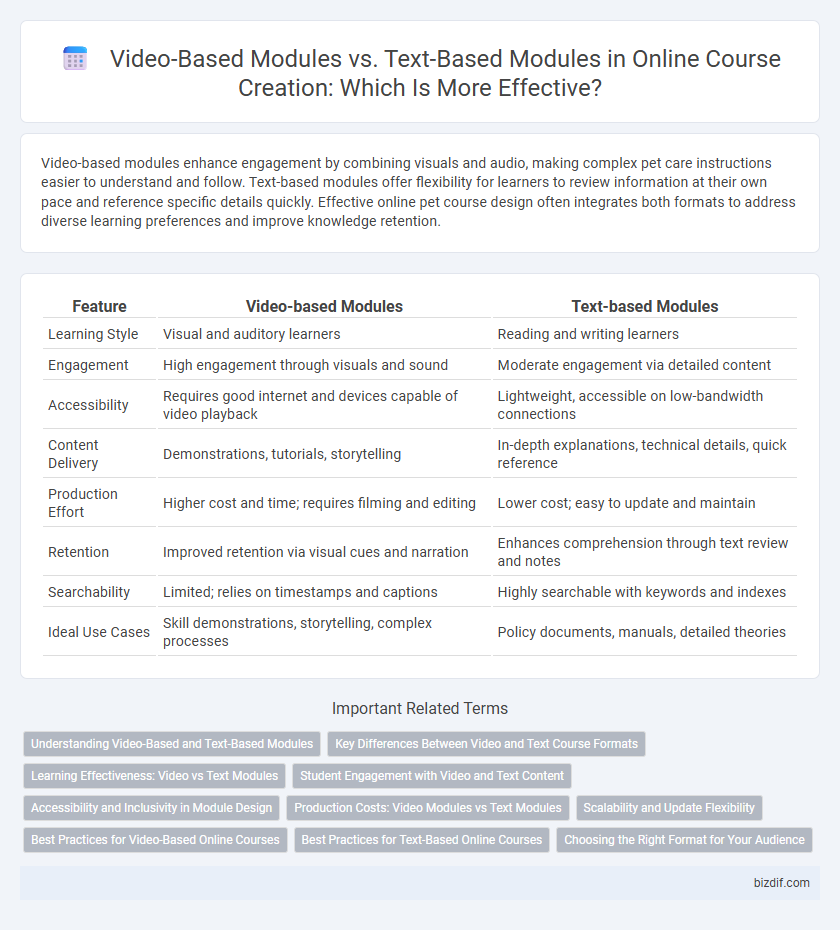Video-based modules enhance engagement by combining visuals and audio, making complex pet care instructions easier to understand and follow. Text-based modules offer flexibility for learners to review information at their own pace and reference specific details quickly. Effective online pet course design often integrates both formats to address diverse learning preferences and improve knowledge retention.
Table of Comparison
| Feature | Video-based Modules | Text-based Modules |
|---|---|---|
| Learning Style | Visual and auditory learners | Reading and writing learners |
| Engagement | High engagement through visuals and sound | Moderate engagement via detailed content |
| Accessibility | Requires good internet and devices capable of video playback | Lightweight, accessible on low-bandwidth connections |
| Content Delivery | Demonstrations, tutorials, storytelling | In-depth explanations, technical details, quick reference |
| Production Effort | Higher cost and time; requires filming and editing | Lower cost; easy to update and maintain |
| Retention | Improved retention via visual cues and narration | Enhances comprehension through text review and notes |
| Searchability | Limited; relies on timestamps and captions | Highly searchable with keywords and indexes |
| Ideal Use Cases | Skill demonstrations, storytelling, complex processes | Policy documents, manuals, detailed theories |
Understanding Video-Based and Text-Based Modules
Video-based modules enhance engagement by combining visual and auditory learning elements, making complex concepts easier to grasp through demonstrations and real-time examples. Text-based modules provide flexible, self-paced study options that allow learners to absorb information quietly and efficiently, with the advantage of easy reference and note-taking. Effective online courses often integrate both formats to cater to diverse learning styles and maximize knowledge retention.
Key Differences Between Video and Text Course Formats
Video-based modules offer dynamic visual and auditory learning experiences, enhancing engagement and retention through demonstrations, animations, and real-time explanations. Text-based modules provide flexibility for self-paced reading, easy reference, and accessibility for learners who prefer or require written content for better comprehension. Key differences include the level of interactivity, user control over pacing, and suitability for different learning styles and content complexity.
Learning Effectiveness: Video vs Text Modules
Video-based modules enhance learning effectiveness by combining visual and auditory stimuli, which improves information retention and engagement. Text-based modules facilitate detailed understanding and allow learners to progress at their own pace, supporting deeper cognitive processing. Studies indicate blended approaches that integrate video and text yield the highest comprehension and application rates in online course creation.
Student Engagement with Video and Text Content
Video-based modules enhance student engagement through dynamic visuals, audio cues, and real-time demonstrations, fostering better comprehension and retention. Text-based modules allow flexible pacing and easy reference, catering to diverse learning preferences and promoting deeper reflection. Combining both formats maximizes learning efficacy by addressing multiple sensory channels and reinforcing key concepts.
Accessibility and Inclusivity in Module Design
Video-based modules enhance accessibility by incorporating features such as closed captions and audio descriptions, benefiting learners with hearing or visual impairments. Text-based modules offer flexibility through screen reader compatibility and adjustable text sizes, catering to diverse learning preferences and abilities. Combining both formats creates an inclusive learning environment that accommodates multiple accessibility needs and maximizes engagement.
Production Costs: Video Modules vs Text Modules
Video-based modules often require higher production costs due to the need for specialized equipment, editing software, and skilled personnel, increasing the overall investment for course creators. In contrast, text-based modules are generally more cost-effective, relying primarily on writing and basic formatting tools with minimal additional expenses. Budgeting for video vs text modules directly impacts resource allocation and pricing strategies in online course development.
Scalability and Update Flexibility
Video-based modules offer high scalability by engaging diverse learners through dynamic visuals and audio, making content easily digestible for a broad audience. They allow rapid updates by simply re-recording sections, ensuring course materials remain current without extensive redesign. In contrast, text-based modules enable quick content modifications and version control but may require more effort to maintain learner engagement at scale.
Best Practices for Video-Based Online Courses
Video-based online courses optimize engagement by incorporating clear visuals, concise scripting, and interactive elements such as quizzes or pause points to reinforce learning. High-quality audio, consistent lighting, and professional editing enhance content retention and maintain student attention throughout the module. Integrating captions and transcripts supports accessibility and improves search engine optimization for course discoverability.
Best Practices for Text-Based Online Courses
Text-based online courses excel when content is organized with clear headings, bullet points, and concise language to enhance readability and learner retention. Incorporating interactive elements such as quizzes, hyperlinks, and multimedia references increases engagement and reinforces key concepts effectively. Prioritizing accessibility through proper formatting, such as alt text for images and consistent font usage, ensures inclusivity and optimal user experience across devices.
Choosing the Right Format for Your Audience
Video-based modules enhance engagement through visual and auditory learning, making complex concepts easier to understand for diverse learners. Text-based modules allow for flexible, self-paced reading and better accommodate learners who prefer detailed, referenceable content. Selecting the right format depends on audience preferences, learning objectives, and content complexity to maximize knowledge retention.
Video-based modules vs Text-based modules Infographic

 bizdif.com
bizdif.com